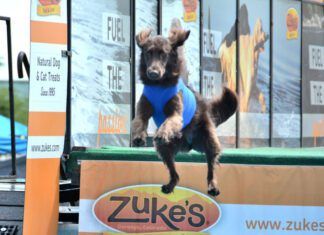Anyone who has ever been bitten (or owned a dog who has been bitten) by a dog, or owned a dog who bit someone (human or canine) – or even just had a good look into a dog’s mouth! – understands that dogs have the potential to harm others. The vast majority of dogs are not dangerous. But, because of the minority who are, there are hundreds of laws, varying state by state and community by community, that attempt to define what dangerous dogs are, and address the consequences of a “dangerous dog” designation to the dogs’ owners and the dogs themselves.
288
Some of these laws are well-written and appropriately enforced, helping protect the community at large from truly dangerous dogs – laws that impose reasonable restrictions on the care and keeping of those dogs – while giving good dogs (and their owners) caught in bad circumstances a chance to redeem themselves. (See the California statutes, as a good example, in the “A look at one state’s dangerous dog laws” section under the “table of contents.”)
In contrast, poorly crafted laws put good dogs at risk and/or fail to protect anyone from dogs who pose a serious threat to other humans or dogs who cross their paths. Poorly crafted and overzealously enforced laws may unfairly, sometimes arbitrarily, set up dogs to fail and burden their owners with sanctions so onerous that they have no choice but to give up, even euthanize, their dogs.
Do you know what kind of laws govern the area where you and your dogs live? You should. Because whether you and your dog got attacked by a stray dog on the street who had a past history of the same behavior, or your dog accidentally nipped a neighbor’s child who was holding your dog’s tennis ball in the air above your dog’s head, the “dangerous dog” laws in your area might have consequences that range from inconvenient to deadly (such as forced euthanasia for the offending dog).
Experts discuss dangerous dog laws
I interviewed two animal professionals who are familiar with different aspects of dangerous dog laws.
The first is an attorney licensed to practice in Virginia, Maryland, the District of Columbia, and Washington State. Heidi Meinzer has been practicing law since 2000, and began practicing animal law in 2010. Heidi represents companion animal owners, trainers, veterinarians, pet care industry companies, and rescues. In March of 2013 she opened her own law firm in Alexandria, Virginia in order to focus her practice on animal law issues. Heidi says, “I have the greatest second job anyone could ask for, as an assistant dog trainer with Fur-Get Me Not, an award winning dog training facility in Arlington, Virginia.” (See http://meinzerlaw.com and http://petlawblog.com for information about Heidi’s practice.)
Paul Miller is a lifetime animal welfare professional, with more than 30 years of experience working at and with humane societies and animal care and control agencies. (Full disclosure, he is also my husband!) Miller began his animal protection career at the Humane Society of Carroll County (Maryland), did undercover investigative work for the Humane Society of the United States (dogfighting, cockfighting, and livestock transport), and has worked at shelters in Arizona, California, Tennessee, and most recently, back in Maryland. His experience with dangerous dog laws is primarily on the enforcement end, which gives him a different perspective from Meinzer’s.
Q. Heidi, what led you to include a focus on animal law in your law practice?
Meinzer: Five years ago, I adopted a beautiful German Shepherd-mix puppy, Sophie. She struggled during fear periods through puppyhood, and around the time she turned two, our older and steadfast Golden Retriever passed away, leaving Sophie to fend for herself. Sophie began showing reactivity to dogs and strangers, leading me to work with several renowned trainers in the Washington, DC, Metro area. Sophie opened my eyes to the world of dog training and behavior, and introduced me to many wonderful professionals.
At about the same time, local rescues involved in a heartbreaking hoarding case in rural Virginia asked me to help them with their efforts to prosecute the hoarder for animal neglect. All of these circumstances made me realize that I could merge my love of dogs and other animals with my legal profession.
Q. Paul, how did you come to be knowledgeable about dangerous dog laws?
Miller: Thirty years experience in enforcement of animal control laws around the country. Most recently, in my positions as director of Chattanooga’s (Tennessee) municipal animal control program and then as executive director of Washington County’s (Maryland) humane society (with an animal contract), I played a significant role in getting modern dangerous dog laws passed in those two communities.
Q. In general, what do you think of the concept of dangerous dog laws?
Meinzer: When I first became aware of Virginia’s dangerous dog law, my gut reaction was that the law was overly harsh. In addition, some provisions of dangerous dog laws can be very onerous and lead to such a financial burden that some owners agree to the dangerous designation when they may in fact have a winnable case, or may even choose to surrender or euthanize their companions. However, I now believe that well-crafted dangerous dog laws with strong procedural protections can serve to balance the rights of dog bite victims and dog owners.
Miller: Unfortunately these laws are a necessity, due to the many dog owners who fail to socialize, train, and/or properly manage their dogs. Without this valuable tool, which gives us the ability to hold the owner responsible for the actions of the dog, it is likely we would have even more severe attacks on humans and other animals.
Q. Heidi, based on your experience with the laws in your area, what do you think of the enforcement/implementation of dangerous dog laws from a defense attorney perspective?
Meinzer: This really varies by state, and then by each locality within each state. Virginia has a statewide dangerous dog statute that cannot be changed on the local level, so the law itself is uniform across all jurisdictions. That said, enforcement and implementation can and does still vary, within the local jurisdictions in Virginia. By contrast, Maryland localities have considerable discretion with their dangerous dog laws. So the local laws themselves, as well as enforcement and implementation, vary tremendously locality by locality.
In some ways, Virginia’s system is preferable, so that at the very least each locality is governed by a uniform law. However, you lose the benefit of flexibility that you have when a state allows localities to pass their own ordinances. For instance, Washington County, Maryland, passed an ordinance that allows for a “potentially dangerous” designation in which dog owners could “work off” the designation by focusing on training and behavior issues with their dogs. This is something that is missing from Virginia’s statute – but that some creative Virginia prosecutors still accomplish through prosecutorial discretion.
Q. Paul, what, if any, are the negatives about these laws, from an enforcement perspective?
Miller: There are several things:
A lot can depend on the training, experience, and knowledge of the investigating officer in regards to canine and human behavior, so application and enforcement can be uneven, even within the same jurisdiction.
Some of the laws aren’t as well-written as others. Definition of terms such as “provocation” may be poorly worded or absent altogether, which can leave it up to the individual officer’s discretion to define and interpret the law.
Dangerous dog laws tend to be reactive rather than proactive – responding to a problem rather than teaching the owner a better way to handle and train his dog. The owner often gives up the dangerous dog only to acquire another dog, and repeat the mistakes that caused the first one to be designated as dangerous.
It makes the dog the victim, when in reality most were just dogs being dogs. Once a dog is designated as dangerous, most laws do not contain a provision to allow for rehabilitative effort and eventual removal of the designation.
A dangerous dog designation can impact on an owner’s ability to get homeowner’s or renter’s insurance, forcing them to rehome or euthanize the dog.
Q. Heidi, what are the most important things for a dog owner to know about dangerous dog laws?
Meinzer: The consequences of dangerous dog laws are often substantial. During the pendency of the case, your dog may be seized and detained at the local pound. If your dog is deemed dangerous, you may have to keep him muzzled in public, hang signs on your property, register with a statewide dangerous dog statute, make potentially expensive changes to your home environment, carry considerable liability insurance that can be quite costly, and comply with a variety of other requirements.
You may be liable for more than just the consequences of dangerous dog laws. Civil liability to the victim is a totally separate matter. Additionally, other laws – such as leash laws or running at large laws – often come into play.
Circumstances leading up to dangerous dog designations often could have been avoided. Not all dog bites are avoidable. But I have seen several cases that would not have occurred if only, for instance, the owner had kept the dog on a leash in a public area.
Q. Heidi, what are the most important things for a dog owner to know about dangerous dog laws?
Meinzer: The consequences of dangerous dog laws are often substantial. During the pendency of the case, your dog may be seized and detained at the local pound. If your dog is deemed dangerous, you may have to keep him muzzled in public, hang signs on your property, register with a statewide dangerous dog statute, make potentially expensive changes to your home environment, carry considerable liability insurance that can be quite costly, and comply with a variety of other requirements.
You may be liable for more than just the consequences of dangerous dog laws. Civil liability to the victim is a totally separate matter. Additionally, other laws – such as leash laws or running at large laws – often come into play.
Circumstances leading up to dangerous dog designations often could have been avoided. Not all dog bites are avoidable. But I have seen several cases that would not have occurred if only, for instance, the owner had kept the dog on a leash in a public area.
Q. What should an owner do to avoid coming into conflict with local dangerous dog laws?
Meinzer: Be a responsible dog owner, plain and simple. The most common factors in dog bite cases include: (1) dogs who are not neutered; (2) dogs who are chained or tethered; (3) selective breeding; (4) dogs suffering from abuse or neglect; and (5) inadequate socialization, training, and supervision. Consider what these factors mean to you as a dog owner.
Get to know as much about your dog as possible before you adopt – and research all that you can about the breeder, rescue, or shelter where you plan to get your dog. Neuter your dog. Keep your dog on leash any time your dog is not in a fully enclosed area, and do not leave her chained or tethered. Properly socialize and train your dog right away. Proactively get a professional opinion from a good trainer and/or behaviorist about any red flags about your dog’s behavior, and address those issues immediately.
Do everything you can to enrich your dog’s world and foster a positive relationship and bond with her. And always take care when interacting with dogs and people wherever you are, including in your own home. If your dog shows any hesitation when meeting another dog or a person, do not force her to interact. Be your dog’s advocate and kindly tell the person that your dog needs space. As another example, set up supervised play dates with people who you know well and who have dogs who are appropriate playmates for your dog instead of going to places like dog parks where the situation is much less under your control.
Miller: I’d suggest making sure your dogs are well socialized; lack of socialization/fearfulness is one of the most common causes of dog bites. Your dogs should also be trained to respond with appropriate and acceptable behavior at home and in public, and well-managed – kept safely confined at home and on-leash in public (unless in designated off-leash areas). Dogs whose owners respect and obey local animal control ordinances are much less likely to get into trouble.
Q. What do you suggest an owner do if her dog is designated as “dangerous” by a local animal law enforcement agency?
Meinzer: Get professional help right away. Contact an attorney who understands not only the law, but also dog behavior. And contact an experienced trainer who can assess your dog’s behavior and point you in the right direction. Evaluate what actions you can take to ensure the safety of your dog and the public, such as desensitizing your dog to a muzzle and walking your dog with proper equipment such as a double leash system with a martingale collar and a front clip harness. Also consider changes to your home environment – such as adding a second storm door or putting up a visible fence – to ensure that your dog will be safely confined on your property.
All of these changes may help convince local animal control officers to allow you to keep your dog at home pending the outcome of dangerous dog proceedings. If your dog is designated as dangerous at the end of the proceedings, make sure that you understand exactly what is expected of you and comply with those requirements. Depending on the applicable laws, failure to comply often can lead to criminal charges against you and the possible euthanasia of your dog.
Miller: I agree. Seek legal counsel, and have your dog evaluated by a qualified/competent animal behavior professional.
Q. Does society have a realistic or appropriate perspective on dogs who bite?
Meinzer: It seems the pendulum swings drastically in opposite directions regarding dog bites. Some people do not take dog bites and incidents seriously enough. Other times, dog bites are overly dramatized. There’s no doubt that the number of dog bite insurance claims is rising, leading many states to consider dog bite liability and insurance laws in a whole new light. Trainers can take action by educating legislators about dog bites so that new laws will actually serve to reduce the number and severity of dog bites.
Miller: I don’t think so. In general the public has limited knowledge of how to develop good behavior in a dog, and/or how to appropriately change or manage unacceptable or undesirable behaviors. They often don’t even recognize or are in denial about the precursor behaviors that are leading up to the incident that’s going to get their dog (and them) in trouble. In most of the media reports on dog-related fatalities, for example, the dog owner claims the dog had never shown any previous danger signs for aggression. In reality, there were likely lots of signals that just were ignored or not recognized by the owner as warning signs. On the other hand, some people seriously overreact to normal dog behavior – owners get sued for a minor nip that, 30 years ago, no one would have thought twice about.
Q. Anything else you would like to say about dangerous dog laws?
Meinzer: As society evolves, we put more and more pressure and expectations on our dogs. We need to realize that this only increases our responsibilities. Build that bond with your dog, and be your dog’s advocate any time your dog seems to be uncomfortable. Accept your dog for who she is, and don’t set goals and expectations based on what you want. Rather, set goals and expectations based on your dog’s needs and desires.
Miller: Dangerous dog laws and other appropriate animal control ordinances should incorporate, whenever possible, an educational component that will help resolve the problem. I have always advocated for a two-tier dangerous dog law. Level One, sometimes called “Potentially Dangerous,” would address the onset of inappropriate behavior prior to a bite or attack, often during a dog’s adolescence, and require the owner to attend training classes or private behavior consults. If, after successful completion of the training requirement and passage of a certain period of time (perhaps 18 months), during which there are no more reported offenses, the designation of Potentially Dangerous could be lifted. Level Two, called “Dangerous” or “Vicious” would address dog behavior that results in serious injury or death to victims.
Some jurisdictions have a “dog school” for animal control violations – like traffic school for traffic violation – that educate owners and allow violations to be removed from their dogs’ records. These are wonderful programs. Whenever possible, the goal should be education, rehabilitation, and helping owners succeed with their dogs, not the imposition of burdensome penalties just for the sake of enforcement.
Pat Miller, CBCC-KA, CPDT-KA, CDBC, is WDJ’s Training Editor. She lives in Fairplay, Maryland, site of her Peaceable Paws training center, where she offers dog training classes and courses for trainers. See page 24 for more information.








